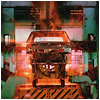
|

農業
- 台風後の日本を助けたアメリカの豚
- 太平洋を横断したリンゴ
- リンゴと国際関係
- リンゴと国際親善
- 日本のミカンと薩摩オレンジ
- ミカンと貿易摩擦
- 世界を家庭に運ぶスーパーマーケット
- 買い物の仕方の違い
|

A grocery store shopper in Virginia.
Photo Courtesy of the United States Department of Agriculture. Photo by Ken Hammond.
Different Food Shopping Styles
While American-style supermarkets have taken some business away from traditional small, specialized neighborhood stores, Japanese and American shopping patterns are still quite different. Americans travel to the supermarket by car, and fill a large, wheeled shopping cart with several days' or a week's worth of groceries and household goods. They then load up the car with many bags of groceries and drive home. They often buy the "large economy size" of everyday items.
Japanese shoppers still tend to go to the supermarket on foot, and to shop for fresh foods nearly every day. They move through the store with a hand-basket or a small shopping cart, and buy only what they will be able to carry home on foot or on public transportation. As a result, Japanese supermarkets do not carry the giant-sized containers that can be found in American supermarkets, and fresh foods are often sold in small packages with one or two servings.
|
|
|
| ポッドキャスト ダウンロード:
英語
| 日本語
|
|
文書 |
ビデオクリップ |
図表 |
写真 |
地図
|
|

